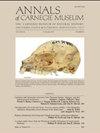中南美洲鬼蛾属(鳞翅目:鬼蛾科)的分类修订及变异生物地理学
IF 0.9
4区 地球科学
Q4 PALEONTOLOGY
引用次数: 2
摘要
摘要/ ABSTRACT摘要:对越南德鲁氏菌属(鳞翅目,大翅目,大翅目)的7种进行了重新描述。该属的单系性由四个自形性支持:1)雄性的后边缘的第8个白蚁,右叶延长;2)前翼有白边肘部斑点;3)雄翅交叉脉CuA1-CuA2上有白色鳞片;4)肘斑从CuA2向后延伸,但未到达肛门静脉或后翼缘。先前命名的德鲁塞ella amazonensis Viette(1950)、德鲁塞ella metellus(德鲁斯,1890)和momus德鲁塞ella(德鲁斯,1890)被证实,而basuceiella basirubra (Schaus, 1901)是德鲁塞ella metellus(德鲁斯,1890)的一个新的低级同义种。提出了3个新种:beckeri Druceiella, hillmani Druceiella和mielkei Druceiella。德鲁塞氏菌的近亲类群尚未确定,但潜在的候选类群为Pfitzneriana Viette(1952)和Phassus [incertae sedis] guianensis Schaus(1940)。德鲁塞氏菌在中美洲和玻利维亚-巴西南部之间的分布被解释为一些物种的迁移和随后的扩散和同域的结果。本文章由计算机程序翻译,如有差异,请以英文原文为准。
Taxonomic Revision and Vicariance Biogeography of the Central and South American Ghost Moth Genus Druceiella (Lepidoptera: Hepialidae)
ABSTRACT The genus Druceiella Viette, 1949 (Lepidoptera, Exoporia, Hepialidae), is re-described for seven species. Monophyly of the genus is supported by four autapomorphies: 1) a posteriorly emarginated eighth tergite with extended right lobe in the male; 2) a white-edged cubital spot on the forewing; 3) white scales on cross-vein CuA1–CuA2 in the male forewing; and 4) cubital spot extending posteriorly from CuA2 but not reaching the anal vein or posterior wing margin. The previously named species Druceiella amazonensis Viette, 1950, Druceiella metellus (Druce, 1890), and Druceiella momus (Druce, 1890) are validated, and Druceiella basirubra (Schaus, 1901) is a new junior synonym of Druceiella metellus (Druce, 1890). Three new species are proposed: Druceiella beckeri, Druceiella hillmani, and Druceiella mielkei. The immediate sister group of Druceiella was not determined, but potential candidate taxa were identified as Pfitzneriana Viette, 1952, and ‘Phassus’ [incertae sedis] guianensis Schaus, 1940. The distribution of Druceiella species between Central America and southern Bolivia-Brazil is explained as the result of vicariance followed by subsequent dispersal and sympatry of some species.
求助全文
通过发布文献求助,成功后即可免费获取论文全文。
去求助
来源期刊

Annals of Carnegie Museum
综合性期刊-动物学
CiteScore
2.50
自引率
18.20%
发文量
4
审稿时长
>12 weeks
期刊介绍:
Annals of Carnegie Museum is a quarterly journal that publishes peer-reviewed short and medium-length original scientific contributions in organismal biology, earth sciences, and anthropology, in 40 by 52.5 pica format (168 by 220 mm or 6-5/8 by 8-5/8 inches). Subject matter must be relevant to Carnegie Museum of Natural History scientific sections or Powdermill Nature Reserve (PNR), preferably with connection to the Carnegie collection and/or personnel. Carnegie Museum staff and research associates receive publication priority, but others are encouraged to submit papers, especially those manuscripts explicitly based on the Carnegie collection.
 求助内容:
求助内容: 应助结果提醒方式:
应助结果提醒方式:


